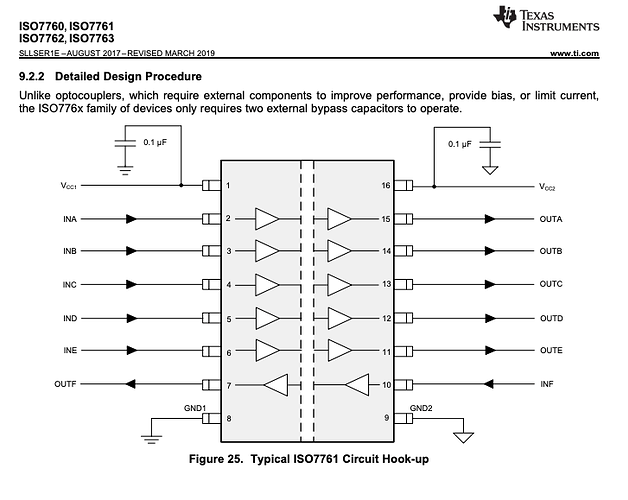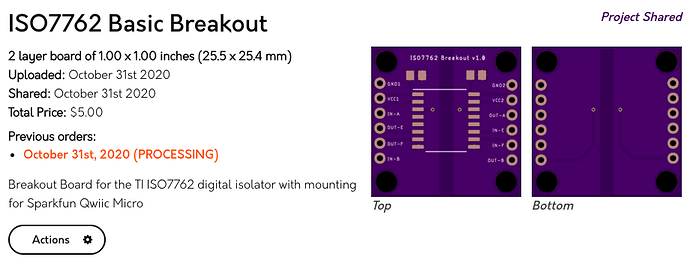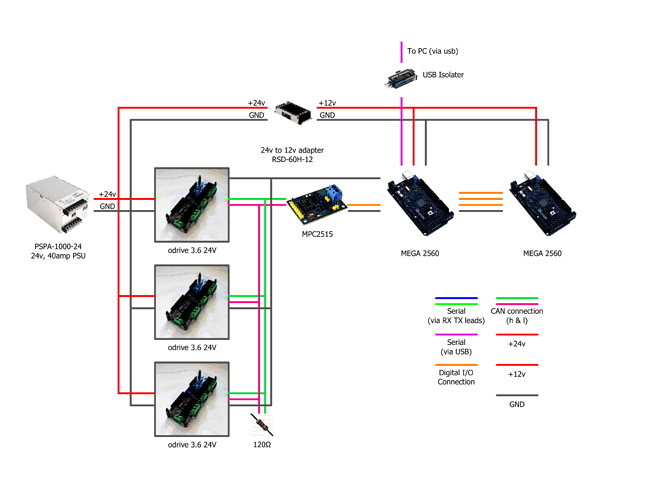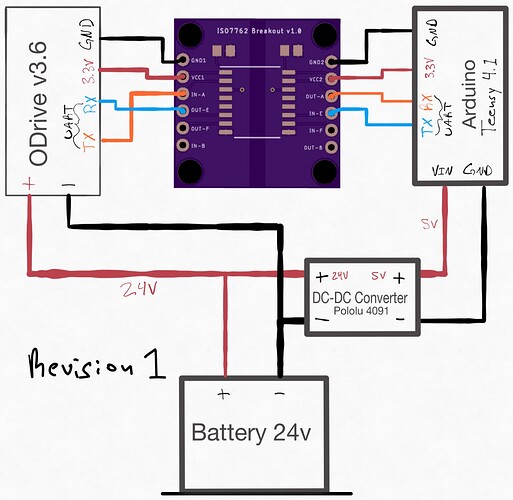For anyone else following along, looking at the ODrive docs recommendation of the TI ISO7762F it does look very strait-forward. They have a dev board for $50 here. Way too expensive for production but worth a look. We might dive deeper into this and make a quick breakout board, will post links to eagle files here if that’s the direction we go. Would love to see this chip integrated into the ODrive for communications isolation it looks great for $3.80 in single quantities.
We are also in the process of designing a “Hat” for the ODrive that isolates the GPIO and provides for differential SPI encoder connections and differential incremental encoders
Hey Ya’ll, just finished this breakout design and posted on OSHPark. I designed this for our application which uses several Sparkfun Qwiic Micros. Mounting and headers should align so that you can solder header pins between the Micro and this board and have full isolation on TX/RX and D0/D8. This is a quick first pass so feedback welcome.
Parts List
1 x ISO7762FDW - SOIC 16
2 x 0805 Caps - 0.1uf
I’m surprised to hear that. It was quite the opposite experience for me. “Differential I2C” was a nasty hack that some predecessor at my work used, with all kinds of spurious faults that went away when you tried to diagnose them but cost us hours of lost data when in the field. Whereas CAN ‘just works’. (provided you set it up right in the first place, but both ODrive and Linux do that part for you: you just give them a ‘baud rate’ like on a serial port)
The “CANSimple” protocol of ODrive really could not be simpler. It is much easier than I2C, that’s for sure.
“Cost of integration” is a board with two chips on. £30-£50 to buy someone else’s board, or £5 if you can design your own. But you only need that once, for all ODrive axes.
@towen thanks for your feedback. Like I said, CAN wasn’t the right solution for us and I can certainly see how it’s the right solution for other folks. Just trying to add new flavors to the mix here.
Hi @Alexander_Jones, I was also looking into making something that could protect ground loops over the last couple of days, as I’m ready to plug in 2 x ODrives to Arduino Mega Serial 1 & 2.
I was of the opinion that Opto-Isolation were slow and relatively expensive, although now being introduced to the ISO7762F chip at 100Mbps by yourself and @madcowswe , and especially seeing your breakout board I’ve decided to give them a go. Also, the fact that it will isolate CAN and SPI is very promising.
Thank you for sharing this.
I’ve ordered 9 of these (as they come in 3’s per order for $5 (very good value)) , where I chose the free postage of 21 days to the UK (could have got it faster, but not in a rush for the additional cost).
I’ve ordered the SMD Parts listed above also, so will let you know how I get on. I’ll still be trying This idea also just in the interim, but for peace of mind, I will settle on the ISO7762F and your breakout all being good.
Kind regards,
Neil.
@Dev255 that’s awesome! Definitely let me know how it goes. We found that these little boards work great.
Hi @Alexander_Jones, will let you know, everything has arrived, although running the mill on a Christmas project at the mo, will fit one of these to it once complete and let you know 
Hello,
Thank you for taking the time to develop this board, I think it might be the perfect solution for my project.
Am I right in thinking that if applied as shown, no ground loops should be formed?
As I’ve had some success controlling one odrive via UART I will likely stick to using this for the time being. In the near future, I would like to give linking everything up via CAN a go, however being a complete novice this seems a bit far fetched for me right now…
Thank you so much!
Dan
EDIT: improved lineweights on diagram
yes, just be aware if you plug in USB to both the Arduino and the ODrive at the same time, you’ll make a ground loop through the USB GND. You can use a USB isolator (available at ODrive shop) to fix this.
Great, thanks!
Although, I have looked and the ISO7763 chips seem to be out of stock pretty much everywhere until next year  I will spend some time looking for an alternative tomorrow, but if you know of a suitable alternative, that would be very helpful.
I will spend some time looking for an alternative tomorrow, but if you know of a suitable alternative, that would be very helpful.
Again, thanks for this,
Dan
Hi,
I was able to order ISO7761, maybe they are available in your country too. As I understand it, it should work with UART, because UART only requires one wire in each direction.
Isn’t there also a ground loop via the PSU, depending on whether GND at the PSU is referenced to mains earth?
Either the main PSU or (ideally) the 24V to 12V adapter should be isolated.
Unfortunately, none of my go-to suppliers seem to have any of these either here in the UK 
Forgive my ignorance, but wouldn’t this be alleviated by using the usb isolator, or am I misunderstanding? Fortunately, the voltage adapter I’m planning on using - Mean Well RSD-60 60W (not shown in original diagram), provides isolation, so I think I’m good? Nevertheless, if you could explain why it could cause a loop, I would appreciate the opportunity to learn!
The more I look into it, the more it makes sense to use a CAN connection. I think I will bite the bullet now and proceed using the MCP2515 module. Here is my proposed layout:
Are there any example bits of code, similar to the ODriveArduinoTest.ino in the odrive GitHub to get me going for communicating via CAN?
Technically correct - the best kind of correct! But it’s never really been a problem as far as I know.
Yep! For the Raspberry Pi  ODrive/can-guide.md at fw-v0.5.3 · odriverobotics/ODrive · GitHub
ODrive/can-guide.md at fw-v0.5.3 · odriverobotics/ODrive · GitHub
You did just remind me I need to do one for Arduino.
This would be great!
Hi @Alexander_Jones,
I’m still here and have the 9 boards that I will soon be using for my mill project, although now I will be running a Teensy 4.1 to control the ODrives via your boards.
I’ve been a little tied up with a heart op, moving and changing my main job, but back on track now.
Will let you know how I get on.
Hi @Alexander_Jones @danbowen95 @Wetmelon , I’m looking to implement the ISO7763 UART Ground Loop solution and was hoping to get some clarification/second set of eyes for the schematic necessary to use it correctly. Please see the following, any feedback is much appreciated!
Thanks,
Matt
Yep looks fine to me.




